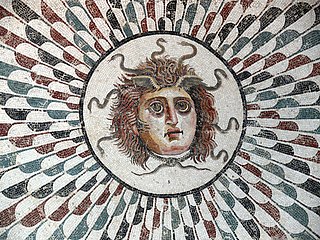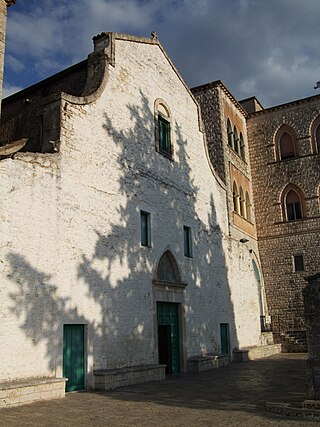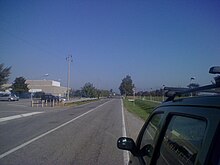
In urban planning, the grid plan, grid street plan, or gridiron plan is a type of city plan in which streets run at right angles to each other, forming a grid.

Timgad was a Roman city in the Aurès Mountains of Algeria. It was founded by the Roman Emperor Trajan around 100 CE. The full name of the city was Colonia Marciana Ulpia Traiana Thamugadi. Emperor Trajan named the city in commemoration of his mother Marcia, eldest sister Ulpia Marciana, and father Marcus Ulpius Traianus.

Antioch in Pisidia – alternatively Antiochia in Pisidia or Pisidian Antioch and in Roman Empire, Latin: Antiochia Caesareia or Antiochia Colonia Caesarea – was a city in the Turkish Lakes Region, which was at the crossroads of the Mediterranean, Aegean and Central Anatolian regions, and formerly on the border of Pisidia and Phrygia, hence also known as Antiochia in Phrygia. The site lies approximately 1 km northeast of Yalvaç, the modern town of Isparta Province. The city was on a hill with its highest point of 1236 m in the north.

Gromatici or agrimensores was the name for land surveyors amongst the ancient Romans. The "gromatic writers" were technical writers who codified their techniques of surveying, most of whose preserved writings are found in the Corpus Agrimensorum Romanorum.

A cadastre or cadaster is a comprehensive recording of the real estate or real property's metes-and-bounds of a country. Often it is represented graphically in a cadastral map.

Curtius Rufus was a Roman professional magistrate of senatorial rank mentioned by Tacitus and Pliny the Younger for life events occurring during the reigns of the emperors Tiberius and Claudius. In all probability, he is to be equated with the first-century Roman historian Quintus Curtius Rufus.
Hyginus, usually distinguished as Hyginus Gromaticus, was a Latin writer on land-surveying, who flourished in the reign of Trajan. Fragments of a work on boundaries attributed to him are found in Corpus Agrimensorum Romanorum, a collection of works on land surveying compiled in Late Antiquity.

Cassano delle Murge is a town and comune in the Metropolitan City of Bari, Apulia, southern Italy.

Cirié is a comune (municipality) in the Metropolitan City of Turin in the Italian region Piedmont, located about 20 kilometres (12 mi) northwest of Turin.

The groma was a surveying instrument used in the Roman Empire. The groma allowed projecting right angles and straight lines and thus enabling the centuriation. It is the only Roman surveying tool with examples that made it through to the present day.

In Roman urban planning, a decumanus was an east–west-oriented road in a Roman city or castrum. The main decumanus of a particular city was the decumanus maximus, or most often simply "the decumanus". In the rectangular street grid of the typical Roman city plan, the decumanus was crossed by the perpendicular cardo, a north–south street.
The archaeological site of Alba-la-Romaine, corresponding to the Gallo-Roman city of Alba Augusta Helviorum or Alba Helviorum is located near the present town of Alba-la-Romaine. The site is in the French department of Ardèche, Rhône-Alpes. During the Roman Imperial era, Alba was the capital of the Celtic-speaking polity of Helvii, which had territory covering the area of lower Vivarais.

The Arch of Augustus in Fano is a city gate in the form of a triumphal arch with three vaults. It is the entrance to the city by the via Flaminia, which became the inside of the wall of the decumanus maximus. It is one of the symbols of the city.

The Arch of Augustus is a gate set in the former city wall of Rimini, Emilia-Romagna, in the form of an ancient Roman triumphal arch.
The Cadaster of Orange also known as the cadastre d'Orange is an ancient Roman era map found at the French city of Orange. The plan is carved in stone and shows the land allocation for the area between Orange and Nice during the 2nd century.

Florentia was a Roman city in the Arno valley from which Florence originated. According to tradition, it was built by the legions of Gaius Julius Caesar in 59 BC; however, the prevailing hypothesis dates the foundation of the city to the Augustan period.
Marcus Junius Nipsus was a second-century Roman gromatic writer, who also dealt with various mathematical questions. His surviving writings are preserved in the Corpus Agrimensorum Romanorum, a compilation of Latin works on land surveying made in the 4th or 5th centuries AD.

Cécile Wajsbrot is a French-Jewish writer, novelist, essayist, translator and journalist. Wajsbrot studied comparative literature in Paris and then worked as a French teacher and radio editor. She has translated books from English and German into French, e.g. by Virginia Woolf, Suzan Wicks, Charles Olson, Gert Ledig and Wolfgang Büscher.

In a typical Roman city, an umbilicus represented the reference point used by the city planners to map out the city spaces, including the pomerium, a sacred city boundary. The place for an umbilicus was supposedly set by examining the sky.
During centuriation, centuria was a basic unit of area, representing a square of 20 actus on a side. The name derives from the fact that in new colonies each centuria can be subdivided into 100 lots of heredium size that were typically allocated to 100 families of colonists.


















